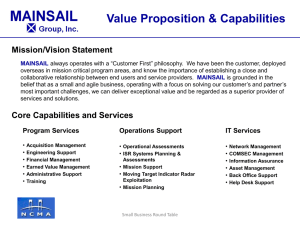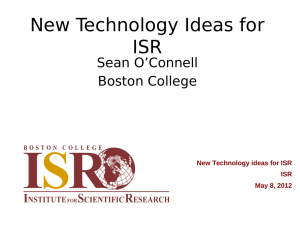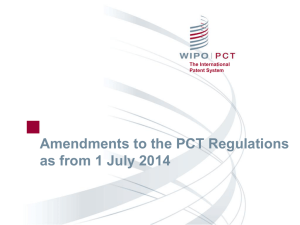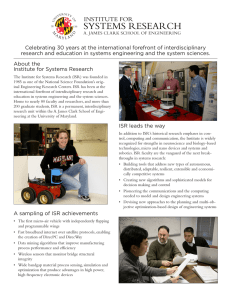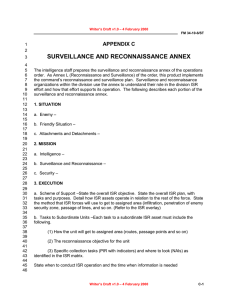First ISR/General Electric Fellowship awarded
advertisement
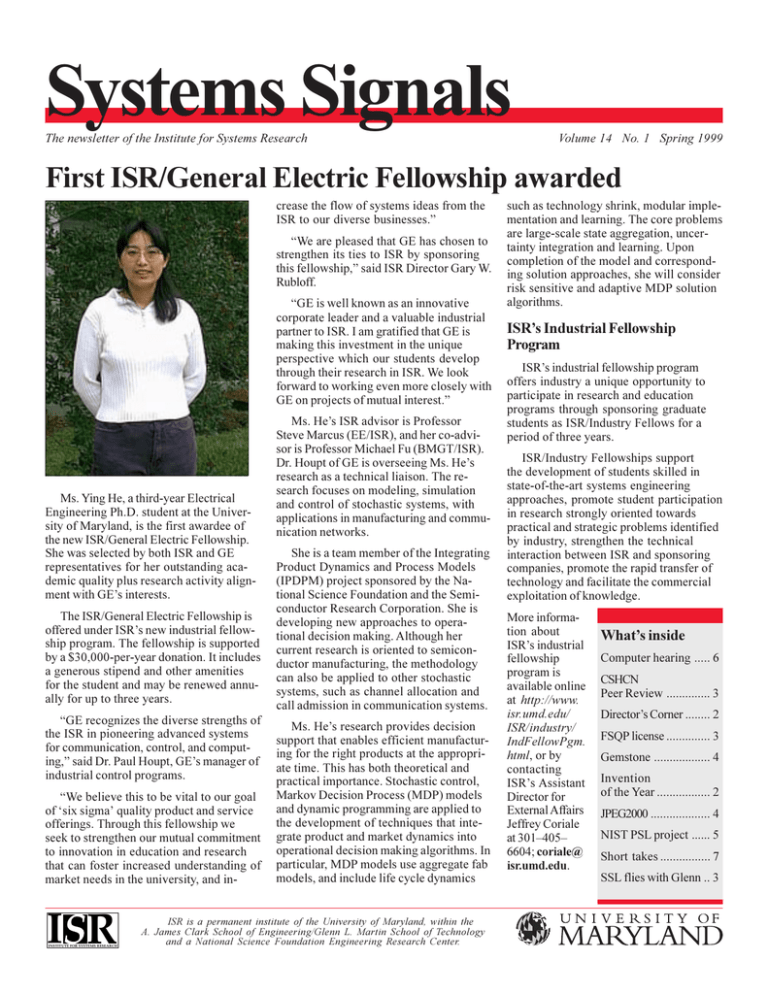
Systems Signals The newsletter of the Institute for Systems Research Volume 14 No. 1 Spring 1999 First ISR/General Electric Fellowship awarded crease the flow of systems ideas from the ISR to our diverse businesses. We are pleased that GE has chosen to strengthen its ties to ISR by sponsoring this fellowship, said ISR Director Gary W. Rubloff. GE is well known as an innovative corporate leader and a valuable industrial partner to ISR. I am gratified that GE is making this investment in the unique perspective which our students develop through their research in ISR. We look forward to working even more closely with GE on projects of mutual interest. Ms. Ying He, a third-year Electrical Engineering Ph.D. student at the University of Maryland, is the first awardee of the new ISR/General Electric Fellowship. She was selected by both ISR and GE representatives for her outstanding academic quality plus research activity alignment with GEs interests. The ISR/General Electric Fellowship is offered under ISRs new industrial fellowship program. The fellowship is supported by a $30,000-per-year donation. It includes a generous stipend and other amenities for the student and may be renewed annually for up to three years. GE recognizes the diverse strengths of the ISR in pioneering advanced systems for communication, control, and computing, said Dr. Paul Houpt, GEs manager of industrial control programs. We believe this to be vital to our goal of six sigma quality product and service offerings. Through this fellowship we seek to strengthen our mutual commitment to innovation in education and research that can foster increased understanding of market needs in the university, and in- I R INSTITUTE FOR SYSTEMS RESEARCH Ms. Hes ISR advisor is Professor Steve Marcus (EE/ISR), and her co-advisor is Professor Michael Fu (BMGT/ISR). Dr. Houpt of GE is overseeing Ms. Hes research as a technical liaison. The research focuses on modeling, simulation and control of stochastic systems, with applications in manufacturing and communication networks. She is a team member of the Integrating Product Dynamics and Process Models (IPDPM) project sponsored by the National Science Foundation and the Semiconductor Research Corporation. She is developing new approaches to operational decision making. Although her current research is oriented to semiconductor manufacturing, the methodology can also be applied to other stochastic systems, such as channel allocation and call admission in communication systems. Ms. Hes research provides decision support that enables efficient manufacturing for the right products at the appropriate time. This has both theoretical and practical importance. Stochastic control, Markov Decision Process (MDP) models and dynamic programming are applied to the development of techniques that integrate product and market dynamics into operational decision making algorithms. In particular, MDP models use aggregate fab models, and include life cycle dynamics ISR is a permanent institute of the University of Maryland, within the A. James Clark School of Engineering/Glenn L. Martin School of Technology and a National Science Foundation Engineering Research Center. such as technology shrink, modular implementation and learning. The core problems are large-scale state aggregation, uncertainty integration and learning. Upon completion of the model and corresponding solution approaches, she will consider risk sensitive and adaptive MDP solution algorithms. ISRs Industrial Fellowship Program ISRs industrial fellowship program offers industry a unique opportunity to participate in research and education programs through sponsoring graduate students as ISR/Industry Fellows for a period of three years. ISR/Industry Fellowships support the development of students skilled in state-of-the-art systems engineering approaches, promote student participation in research strongly oriented towards practical and strategic problems identified by industry, strengthen the technical interaction between ISR and sponsoring companies, promote the rapid transfer of technology and facilitate the commercial exploitation of knowledge. More information about ISRs industrial fellowship program is available online at http://www. isr.umd.edu/ ISR/industry/ IndFellowPgm. html, or by contacting ISRs Assistant Director for External Affairs Jeffrey Coriale at 301405 6604; coriale@ isr.umd.edu. Whats inside Computer hearing ..... 6 CSHCN Peer Review .............. 3 Directors Corner ........ 2 FSQP license .............. 3 Gemstone .................. 4 Invention of the Year ................. 2 JPEG2000 ................... 4 NIST PSL project ...... 5 Short takes ................ 7 SSL flies with Glenn .. 3 The diversity of ISRs impact This issue of Systems Signals reveals a wealth and diversity of ISR accomplishments. Students stand out strongly. Ms. Ying He has received the first ISR/GE Fellowship. Brian Roberts M.S. project led to a new space tool which flew with John Glenn on Discovery in October. Naoko Sumino was selected as an astronaut from Japan assigned to the International Space Station. Bob Hoffmans Ph.D. thesis received an award at the INFORMS meeting (Bob is now a postdoc in NEXTOR). And two student teams led by Dave Stewart were in the top 10 finishers in the Motorola University Design Contest. The Gemstone honors program, conceived by Dean Destler and administered by ISR, continues to be a prime source of campus pride as well as a highly recognized innovation in undergraduate education. ISR faculty are well represented in the teaching and mentorship of this program, whose exciting interdisciplinary team projects cover the spectrum from genetic testing to managed health care, computing with biological systems, and antibiotics and resistant bacteria. Faculty awards and honors include several NSF CAREER awards to promising young faculty (Don DeVoe, Linda Schmidt, and former student Nick I R INSTITUTE FOR SYSTEMS RESEARCH The Institute for Systems Research is a permanent state-supported institute of the University of Maryland, within the A. James Clark School of Engineering and the Glenn L. Martin School of Technology. ISR has a continuing affiliation as a National Science Foundation Engineering Research Center. Gary W. Rubloff, Director Rebecca Copeland, Systems Signals editor A.V. Williams Building (#115), University of Maryland, College Park, MD 20742 Phone (301) 405-6632 Fax (301) 314-9920 email: isr@isr.umd.edu URL: http://www.isr.umd.edu Systems Signals is printed on recycled paper. Page 2 Sidiropoulos), prominent honors within the university (the Mancur Olson Research Achievement Award for John Baras and a Distinguished Faculty Research Fellow for P.S. Krishnaprasad), and recognition by professional societies (for Michael Fu, Stuart Antman, Steve Marcus, and Bill Levine). And this semester three ISR faculty members (Mark Austin with David Chancogne, Guangming Zhang, and Lung-Wen Tsai) have produced new books. Finally, Ben Shneiderman and John Baras have both been featured in the news media. Features in this issue illustrate the major impact of ISR research across a broad spectrum of systems challenges. The Center for Satellite and Hybrid Communication Networks received strong praise from its NASA sponsors as well as the National Academy of Public Administration. The Center for Auditory and Acoustic Research is pioneering the investigation of the auditory nervous system and its implications from biology and medicine to new approaches to sensing and computation. Directors Corner ISRs research generates not only fundamental knowledge, but also clear directions for technology evolution, exemplified by the image coding work of Mitsubishi Electric visiting researcher Eiji Atsumi with Nariman Farvardin, chair of Electrical Engineering. ISR faculty in manufacturing hosted a NIST roundtable aimed at developing a new Process Specification Language. The optimization methodology pioneered by André Tits, already used in 57 countries around the world, has been licensed to Cadence, a leading supplier of circuit design tools. And inventions by research groups of Jim Hendler and Dana Nau have been honored by the university. What does this diversity mean? It signifies the multiple objectives of ISRs agenda, including excellence in research, leadership in technology-based systems, impact on and relevance to industry, innovation in cross-disciplinary and particularly systems-oriented education, and the development of outstanding students who are well prepared to function as leaders in their careers. Bridge Baron is finalist in contest PARKA-DB wins Universitys Invention of the Year Associate Professor Jim Hendler (CS/ISR) and two of his graduate students, Killian Stoffel and Merwyn Taylor, won the University of Marylands 1998 Invention of the Year award. Their invention, PARKADB, is a high-performance knowledge representation (KR) system that deviates from the norm by using a database-management system to provide run-time storage advantages. PARKA-DB supports the same representational functionality as its memory-based predecessor, but also supports larger knowledge bases while consuming less internal memory. PARKA-DB is projected to be a useful KR technology for computer systems limited by main memory, running on todays smaller personal com- puters and individual workstations. http:// www.cs.umd.edu/projects/plus/Parka/ parka-db.html The contract bridge computer program developed by Professor Dana Nau (CS/ ISR), Ph.D. graduate Steve Smith and Tom Throop, head of Great Game Products, Inc., was a finalist for the award. In 1997 Bridge Baron won the American Contract Bridge Leagues computer bridge tournamentmaking it the world champion. http://www.cs.umd.edu/~nau/bridge/ bridge.html The Invention of the Year Award is sponsored by the universitys Office of Technology Liaison. http://www.otl.umd. edu/ Systems Signals CFSQP licensed to Cadence CSHCN receives high marks on Peer Review The University of Maryland has reached an agreement for a nonexclusive license to CFSQP source code for use in Cadences Resolve Optimizer for Analog Artist for a one-time six figure fee. The license agreement was negotiated through the Universitys Office of Technology Liaison. The Center for Satellite and Hybrid Communication Networks (CSHCN) has received the final report from its October 29, 1998 peer review. The review was authorized by NASA and conducted by representatives of the National Academy of Public Administration (NAPA). The CSHCN program was evaluated based on three criterion: alignment with NASA missions, quality and innovativeness of technology development, and flexibility and alignment with NASA programs while maintaining Center viability through industrial partnerships and joint programs. This is, by far, the largest commercial agreement so far directly based on my research, said Professor André Tits (EE/ ISR), who has led the FSQP development team for more than a decade. Its rewarding to see that what you do is being put to good use. FSQP is a superlinearly convergent algorithm for directly tackling optimization problems with multiple competing linear/ nonlinear objective functions (minimax), linear/nonlinear inequality constraints, and linear/nonlinear equality constraints. The algorithm contains special provisions for maintaining semi-feasibility of each iterate and efficiently handling problems with many sequentially related objectives and/or constraints. With the addition of a site in the Philippines in early 1999, FSQP optimization software is now being used in 57 countries around the world. The Institute for Systems Research Visit CSHCN online at http://www.isr. umd.edu/CSHCN/. Suzanne Kirchhoff, CSHCN Space Systems Lab project flies with Glenn; former ISR student now Japanese astronaut The SEM-04 sat right about here The first version of the Fortran implementation of FSQP (FFSQP; initially simply called FSQP) was released in 1989. The algorithms main architects were Dr. Eliane R. Panier and André Tits. The implementation was due to Dr. Jian Zhou. The first version of the C implementation (CFSQP), carried out by graduate student Craig Lawrence, followed in 1993. The successive versions of both packages were made widely available over the Internet. Visit the FSQP web site at http:// www.isr.umd.edu/Labs/CACSE/FSQP/ fsqp.html. The list of countries using FSQP is at http://www.isr.umd.edu/ISR/ newsletter/sssu97/fsqpcountries.html. The report indicates that CSHCN excelled in all three areas. A paragraph on page 9 of the report summarizes the review teams assessment: The CSHCN is playing a key role in research on hybrid communications technology, an extremely important area from the perspective of global competition. Its high quality work makes it a leader in the field of hybrid communication networks. Space Systems Lab (SSL) M.S. candidate Brian Roberts thesis research project, a three-dimensional roller mechanism sprag wrench, flew with John Glenn and the rest of the Discovery astronauts on their October 1998 space shuttle mission. The goal of the experiment was to study how the 3-D rollers behave in a period of extended micro-g. The EVA 3-D roller wrench operates using 3-D rollers connected with springs installed between concentric cylindrical races. It is being considered for flight on a future Hubble Space Telescope Servicing Mission and also for International Space Station construction missions. SSL has an excellent web page covering the wrenchs flight at http://www.ssl. umd.edu/wrench/EVA/SEM/. Naoko Sumino has been selected as one of three Japanese astronauts for the International Space Station. Sumino is a former ISR student who worked in the Space Systems Lab and is currently with the National Space Development Agency of Japan (NASDA). Sumino, 28, is now Japans second female astro-naut. The International Space Station is being built by the United States, Russia, Canada, Japan, 11 nations of the European Space Agency and Brazil. It is scheduled to be completed in 2004. Page 3 Japanese researcher, ISR professor team for JPEG2000 image coding project Nariman Farvardin, who chairs the Universitys Electrical Engineering Department and holds a joint appointment with ISR. Mr. Atsumi was the third Mitsubishi Electric employee to have worked with Dr. Farvardin. sity and Mitsubishi in JPEG2000-related activities, two patent applications (March 1998 and September 1999) were filed as a joint invention. These joint inventions were treated under a technology transfer from the University to Mitsubishi. What I wanted to do with Dr. Farvardin was start a new project, apply for a patent, and put the idea into future commercial applications, Mr. Atsumi said. I wanted to have one cycle of experience as a corporate researcher while I was in the United States. Because I had no experience writing patents with an American patent attorney, I had to get over lots of logistical issues, Mr. Atsumi said, such as how to work with an attorney and explain technologies over the phone. But once the job was done, Mr. Atsumi said, I could enjoy another sense of achievement. The standardization project started shortly before Mr. Atsumi arrived at Maryland. One important aspect is to develop a unified image coding system which will address a wide variety of application scenarios. At the end of December Mr. Eiji Atsumi of Japans Mitsubishi Electric concluded a 16-month-long visiting researcher stay at the University of Maryland. While here, Mr. Atsumi worked on the JPEG2000 image coding project. The projects goal is to establish a new standard that will be more widely used than JPEG and will either replace or coexist with the current still image coding standard. Mr. Atsumi worked with Professor Mr. Atsumi and Dr. Farvardins contribution to JPEG2000 is the functionality called ROI (Region of Interest). ROI makes the image coding system application-friendly, for example, in telemedicine applications or in downloading an image over the Internet. While here, Mr. Atsumi learned about the process of applying for a U.S. patent. Since I was representing both the univer- Mr. Atsumi noted that technology transfer is much more of an issue in the U.S. than it is at Japanese corporations. Through this activity, I have learned about technology transfer issues, and considering that these issues will eventually become active in Japanese corporations, this will be a valuable experience for future technology transfers. Mr. Atsumi considers the time he spent at the University very valuable. I will be glad to continue my interaction with all of these people after I return to Japan. Gemstone news ISR administers the University of Marylands Gemstone honors program, which addresses two of the most common criticisms of modern undergraduate educationthe lack of an integrative experience to provide a context for learning, and the failure to provide meaningful interactions between students in different disciplines. In interdisciplinary teams, students work on a major project with technological and social implications for three years. As a group, Gemstone students have an average SAT score above 1400. Close to 400 students are now in the program. A proposal by Professor Dana Naus (CS/ISR) Flexible Factories group of seven third-year Gemstone students was Page 4 accepted by the 1998 Artificial Intelligence and Manufacturing Workshop: State of the Art and State of Practice. First-year Gemstone students Sabastian Niles, Melissa Murray, Peggy Wood and Maggie Lassack were named four of the University of Marylands Top 10 Freshman by the national leadership honor society Omnicron Delta Kappa. Admiral Stansfield Turner, former director of Central Intelligence, was the first Gemstone Distinguished Lecturer of the academic year. He challenged freshman Gemstone honors students to include projects with national security themes, particularly arms reduction, when they select their long-term projects. The second class of Gemstone undergraduate honors students has chosen its long-term projects. You can view the progress of many of the projects from both the class of 2000 and 2001 online at http://www.isr.umd.edu/gemstone/ GemstoneWebpage/Teams/2000T.html and http://www.isr.umd.edu/gemstone/ GemstoneWebpage/Teams/2001T.html. Projects and advisors of the inaugural class of 2000 The Flexible FactoryDana Nau, CS/ ISR, Satyandra Gupta, ME/ISR Systems Signals The Psychological Impact of LongTerm Computer UseKent Norman, PSYC Genetic TestingJudy Olian, BMGT Mass TransitDavid Sicilia, HIST Privacy and Security with Information WarfareJames Hendler, CS/ISR, William Gasarch, CS Information Technology and MedicineDouglas Oard, LBSC Space FlightDavid Akin, AE/ISR Reclamation of the Chesapeake Bay Neil Blough, BIO-CHEM, George Helz, RESOURCE CENTER Projects and advisors of the Inaugural Class of 2001 Nuclear and Other Waste Disposal Alice Mignerey, BIO-CHEM Desensitization to Violence: Youth EducationPeter Leone, SPED Antibiotics and Resistant Bacteria William Bentley, CHEM-E Improvement of the National CurriculumAllison Druin, EDUC Computing with Biological Systems Shihab Shamma, EE/ISR Global CommunitySuheil Bushrui, BSOS Affordable Public HousingRalph Bennett, ARCH; Alex Chen, US&PL Prisons: Rehab or StorageCharles Wellford, CJ/CRIM Resource Allocation and the Space ProgramMark Lewis, AE Managed Health CareMark Meiners, CTR AGING ISRs CIM Lab hosts NIST Process Specification Language Project Roundtable II From Jan. 13-14, ISRs Computer Integration Manufacturing Lab (CIM Lab) and the University of Maryland hosted the National Institute of Standards and Technologys Process Specification Language Roundtable II. The event brought together some 30 government, academic and corporate researchers working on the Process Specification Language Project (PSL project). For many years NISTs Manufacturing Systems Integration Division has been involved in the definition of a neutral representation of product data, most recently realized through the STEP standard. With that effort well underway, another candidate area for a division focus is the representation of manufacturing process. Like product data, process data is also used throughout the life cycle of a product, from early indications of manufacturing process flagged during design, through process planning, validation, production scheduling and control. In addition, the notion of process also underlies the entire manufacturing cycle, coordinating the workflow within engineering and shop floor manufacturing. The PSL project is defining a neutral representation (language) for process which could be used for the sharing of process data among all of the functions identified above. NIST provides an online overview of the project at http://www.nist. gov/psl/. With v.1.0 of PSL nearly finalized, the roundtable built a broad consensus among those who have been involved with or will benefit from the work. Professor Michael O. Ball (BGMT/ISR), Assistant Professor Satyandra K. Gupta (ME/ISR), Assistant Professor Jeffrey W. Herrmann (ME/ISR), Professor Dana S. Nau (CS/ISR) and ISR Research Engineer Ed Lin, along with numerous ISR students, participated in the roundtable and hosted a reception demonstrating the work of CIM Lab. Life at All Costs?Laura Wilson, CTR AGING ENews service, ISR NSF report available Innovative Power SourcesReinhard Radermacher, ME ISR introduces ENews, a short monthly notice mailed to your e-mail address. ENews will update you on approximately five to seven ISR news items, complete with appropriate URLs and contact information. To subscribe, fill out an easy two-step online form. You may unsubscribe at any time. You can learn more and subscribe at http://www.isr. umd.edu/ISR/industry/ENewsform.html. Crumbling InfrastructureJacqueline Rogers, PUB-A; Susanne Slater, PUB-A More information about Gemstone is at http://www.isr.umd.edu/gemstone. The Institute for Systems Research ISRs latest report to the National Science Foundation, Summary Statement of Value Added to Industry and the Nation, is a 12-page quick introduction to ISRs philosophy and work. It is available online in PDF, Postscript and html versions. You can read or download it online at http://www.isr.umd.edu/ISR/ publications.html. Page 5 On the frontiers of computer hearing When representatives from Billboard magazine called Professor Shihab Shamma (EE/ISR) asking for help automating the research for their top 40 list, he had to turn them down. To create its list, Billboard hires people to listen to the radio and record how many times they hear certain songs. The magazines people thought this process could be computerized, and that Shamma, who directs ISRs Center for Auditory and Acoustic Research (CAAR), could program computers to recognize the songs. models and algorithms. Then they will implement these algorithms in software and compare the softwares performance with human standards. Professor John Baras (EE/ISR) has worked on the classification of algorithms specifically for the auditory system. Many factorspitch, timbre, volume must be programmed into voice recognition software. This would lead to capabilities such as morphingintertwining different voicesand of course, recognizing music, which is what Billboard is after. The University of Maryland uses this process for a wide range of research, and CAARs academic and industry partners have used similar methodologies in a number of other applications, Shamma says. And for what the magazine envisions to work, there would need to be a way to feed radio signals into a computer. Without that technology, computers could identify only the simplest melodies. He cannot. Computers do not yet have the ability to process complex sounds, Shamma says. Developing this technology is but one application of Shammas research in auditory processing at CAAR and the Neural Systems Lab (NSL), one of ISRs constituent laboratories, which Shamma also directs. For example, the University of Washington has worked with Boeing Corp. on improving robotic performance. The company wants a computer to recognize when a drill sounds broken so it can alert a technician on a monitor. Boston University works with the mathematical modeling of psychoacoustics. CAAR is a consortium of researchers from academia, government and industry. The Office of Naval Research funds the center through a Department of Defense 1997 Multidisciplinary University Research Initiative. Signal processing algorithms also have military applications. Some of the best known are smart mines, which would ignite only when they heard the sound of a tank. Another application is the detection of underwater transients, which would allow submarines to recognize the sounds of other submarines. CAAR conducts theoretical and experimental research into the human auditory nervous system, which far outpaces a computers ability to process such complex acoustic environments as popular songs. The key focus of the research, Shamma says, is to determine how the brain processes, recognizes and acts upon sounds. For instance, human brains have a complex ability to filter out irrelevant sounds. Students engaged in an interesting lecture can listen to the professor while ignoring the sounds of someone walking down the hall or of traffic outside. By contrast, if computers could hear, they would attempt to process all those sounds at once, indiscriminately. I think all tasks that involve humanlike performance [are] very difficult tasks for computers, Shamma says. The brain has an entirely different structure than a computer chip. So the researchers must determine how the auditory system works by using mathematical Page 6 ISRs Neural Systems Lab bases much of this technology on the analysis of multichannel sensory data. The lab has developed VLSI-based hardware to parallel an electronic analog of human sensory systems. One goal of the system is to eventually recognize human voices. Some computers already employ voice recognition for security purposes, but only to the extent that they can identify a particular voice. And that doesnt even work all the time, Shamma says. He recalls hearing about a teenager whose voice was too unstable for the computer to recognize every time. Itd be hopeless for something as complex as a Bach fugue, Shamma says, but itd be doable for Mary Had a Little Lamb. NSL currently does not have funding for that particular research. The lab instead focuses on learning the principles of biological processes, which Shamma calls neuromorphic engineering. The technology would come after the researchers understand how auditory processing happens naturally. Its like learning how to fly by observing birds, Shamma says. You have to learn the principles before you can build something. Other ISR faculty involved in CAAR are John Baras, P.S. Krishnaprasad (EE/ISR) and Steve Marcus (EE/ISR). Universities involved in the CAAR consortium include the University of Maryland, Boston University, the University of Maryland at Baltimore; the University of Washington; and the University of Zurich. Industry partners are Alphatech, Interval Research, Silvaco International, Texas Instruments, Prometheus and BFGoodrich Aerospace. For more information, visit the CAAR web site at http://www.isr.umd.edu/CAAR/, the NSL web site at http://www.isr.umd.edu/ Labs/NSL/nsl.html, or contact Shihab Shamma, (301) 405-6842, sas@isr.umd.edu. Jeremy Bond, ISR student intern Word recognition is another challenge. The human auditory system can recognize the word bread no matter who says it. But computers are too fidgety to ignore even subtle pronunciation differences of the same word. Systems Signals Short takes ISR in the media Professor Ben Shneiderman (CS/ISR), head of the ISR-affiliated Human Computer Interaction Lab (HCIL), was profiled in the March 1999 issue of Scientific American magazine. The article focused on his views regarding machine intelligence, specifically software agents. HCIL was featured on the Maryland Public Television program, Maryland State of Mind on January 28 and February 4. The segment Softer Software highlighted HCIL Professor Allison Druins work with children. The Baltimore Sun also covered work Druin and Ben Bederson did with children in a Dec. 21, 1998 article. Professor John Baras (EE/ISR) appeared on the Washington, D.C. five oclock news February 10. Channel 7 interviewed Dr. Baras for a segment explaining wireless communication innovations. Awards and honors Two ISR faculty members have won National Science Foundation Faculty Early Career Development (CAREER) Awards. Assistant Professor Don DeVoes (ME/ISR) award is for research in Mechanically Robust Micromechanisms, while ISR-affiliated Assistant Professor Linda C. Schmidts (ME) is for her work in Generative Designer Assistance Tools. In addition, Nick Sidiropoulos, who is now at the University of Virginia and earned his Ph.D. with ISR and the Electrical Engineering Department, has received a CAREER award. CAREER awards support exceptionally promising college and university junior faculty committed to the integration of research and education. Professor John Baras (EE/ISR) received the University of Marylands Mancur Olson Research Achievement Award. The award was created to recognize faculty with extraordinary research achievements. Professor P.S. Krishnaprasad (EE/ISR) was honored as one of three 1998 Distinguished Faculty Research Fellows by the University of Maryland Graduate School. Professor Stuart Antman (Math) is a corecipient (with John Ball of the University of Oxford, U.K.) of the 1999 SIAM Theodore von Karman Prize. SIAM awards the prize for a notable application of mathematics to mechanics or to the engineering sciences. Professor Antman received the award for his deep work on the modeling and analysis of The Institute for Systems Research strings, rods, plates and shells including bifurcation theory and qualitative properties of solutions. Professor Michael Fu (BMGT/ISR) won the 1998 Outstanding Simulation Publication Award from the INFORMS College on Simulation for his research monograph, Conditional Monte Carlo: Gradient Estimation and Optimization Applications. The publication was co-authored with Jian-Qiang Hu. Associate Professor Jim Hendler (CS/ UMIACS/ISR) has been chosen as a member of the U.S. Air Force Scientific Advisory Board. The AFSAB is one of the two most respected advisory boards to the U.S. Department of Defense (the Defense Science Board is the other), and reports directly to the Chief of the Air Force. Members of the Board, now in its 50th year, include academics, industry leaders, and retired military general officers. Jim is the second University of Maryland faculty member on the current board. College of Business and Management Dean Howard Frank is also currently serving. sored by the Semiconductor Industry Association. This effort brought together industry and academic leaders to define the technological challenges facing the semiconductor industry in coming years. New books Professor Lung-Wen Tsai (ME/ISR) is the author of a new book, Robot Analysis: The Mechanics of Serial and Parallel Manipulators, published by John Wiley & Sons, Inc. Professor Guangming Zhang (ME/ISR) has written Quality Management in Systems, published by The Commercial Press, Bejing. Associate Professor Mark Austin (CE/ ISR) and ISR Faculty Research Assistant David Chancogne have written Introduction to Engineering Programming: in C, MATLAB, and JAVA, published by John Wiley and Sons. Faculty additions Former ISR Director and Professor Steve Marcus (EE/ISR) is on the editorial board of a new SIAM series of texts and monographs on advances in design and control. The SIAM Series on Advances in Design and Control will publish texts and monographs dealing with all areas of design and control and their applications. The series will focus on the mathematical and computational aspects of engineering design and control. ISR welcomed five new faculty members in fall 1998. Assistant Professor Satyandra K. Guptas (ME/ISR) research focus is on design and manufacturing integration. His general interests are in design for manufacturing, manufacturing planning, mass customization, micro-electro-mechanical systems (MEMS), modeling and simulation of manufacturing systems and rapid prototyping processes. Professor William Levine (EE) received the 1998 Schroers Award for Outstanding Rotorcraft Research from the San Francisco Bay Area Chapter of the American Helicopter Society. It was presented to the CONDUIT team, of which Levine is a member. Other team members include Mark Tischler and Kenny Cheung, U.S. Army at NASAs Ames Research Center; Jason Colbourne, NASA; and Chad Frost, California Polytechnical Institute. CONDUIT is the acronym for Control Designers Unified Interface. It is a state-of-the-art computational facility for aircraft flight control design, evaluation, and integration for modern fixed- and rotary-wing aircraft. Information about CONDUIT can be found at http:// caffeine.arc.nasa.gov/conduit/. Assistant Professor Haralabos Papadopoulos (EE/ISR) interests are in communications and signal processing with an emphasis on wireless communications and nonlinear signal processing. He has developed powerful, low complexity algorithms for digital encoding and estimation of noisy signals. ISR Director Gary Rubloff served on the Metrology Technology Working Group for the construction of the 1997 National Technology Roadmap for Semiconductors, spon- Assistant Professor Linda C. Schmidt (ME) established the Designer Assistance Tool Lab (DATLab) in the Department of Mechanical Engineering. Her research vi- Assistant Professor S. (Raghu) Raghavans (BMGT), research interests span both theory and applications. His work focuses on network optimization and integer programming. He has developed new insights and ways to strengthen model formulations and devised an efficient dual-ascent technique to solve network design problems with connectivity requirements. Page 7 Systems Signals Non-Profit Org. U.S. Postage PAID College Park, MD 20742 Permit No. 10 The Institute for Systems Research A.V. Williams Building (#115) University of Maryland College Park, MD 20742-3311 sion is to develop the next generation of designer assistance tools. Her collaborative work includes industrial equipment design, open collaborations with NIST researchers, a statistical process control approach to creating adaptive simulated annealing optimization schedules, and functional representation issues in design theory. Assistant Professor John N. Kidder, Jr. (MNE) is affiliated with the Laboratory for Advanced Materials Processing. His research studies the physics and chemistry of thin film growth from several perspectives: thin film growth by metal-organic chemical vapor deposition (MOCVD); in-situ process diagnostics: real-time analysis of process chemistry and dynamics; and surface analysis of thin films. His goal is to uncover the basic mechanisms that govern thin film formation. Gupta and Papapopoulos are joint appointments; Raghavan, Schmidt and Kidder are affiliated faculty. In addition, Assistant Professor Greg Walsh (ME/ISR) has been named to a joint faculty appointment. Patent awarded Congratulations to Associate Professor K. J. Ray Liu (EE/ISR) and 1996 ISR Ph.D. graduate Ut-Va Koc, who now hold U.S. Patent Number 5,790,686 for their invention, DCT-Based Motion Estimation. Staff and student news ISRs Executive Assistant Rita Riddle left the A.V. Williams Building via limousine on August 31 when she retired after 33 years of service to the University of Maryland. During this time, she worked for just two entities: ISR (for the past eight years) and the Maryland Technical Advisory Service, now the Institute for Governmental Service (for the first 25 years). Rita was ISRs first retiree. She served all three ISR directors: founding director John Baras, Steve Marcus, and Gary Rubloff. Congratulations to ISR staff members Jeanette Tarter (Administrative Assistant II) and Frank Briggs (Accounting Associate), who received 1998 Exceptional Performance Awards for Non-Exempt Staff in the A. James Clark School of Engineering. They were two of nine staff chosen in the entire college and were selected for their outstanding accomplishments and contributions to ISR and the campus. NEXTOR Research Associate Bob Hoffmans Ph.D. thesis, Integer Programming Models for the Ground Holding Problem in Air Traffic Management was awarded second place in the INFORMS Transportation Science Section Dissertation Prize. Bobs thesis can be viewed or downloaded online at http://www.isr.umd.edu/ TechRe-ports/NEXTOR/1998/NEXTOR_ TR_98-1/NEXTOR_TR_98-1.phtml. Two University of Maryland student teams led by Assistant Professor David B. Page 8 Stewart (EE) were top-10 finishers in the 1998 Motorola University Design Contest, which showcased Motorolas 16-bit 68HC12 microcontroller (MCU) architecture. Angelo L. Capili, Thomas Carley and Elizabeth Rosenfeld made up the Computer-Controlled Electric Trains team. Their project provides the model train user with visual, auditory, tactile and realistic means of interacting with the trains. It is also an implementation tool for research in real-time systems to test error handling and detection software architecture for embedded systems. Moussa Abdoul Ba and Sujaya Srinivasanof were the Home Automation System team. The microcontroller was used for remote monitoring of rural homes that must rely on solar power for its energy needs and cellular technology for communication. ISR awards At ISRs annual awards ceremony, Director Gary Rubloff presented awards for outstanding performance to Thomas McAvoy (faculty), Jeanette Tarter (staff), Philip Flip Korn (grad student) and Keith Holleman (under-grad student). Events Albert Pisano of the Defense Research Projects Agency (DARPA) and the University of California at Berkeley explained DARPAs five-year vision for MicroElectroMechanical devices at an ISR/EE colloquium on Nov. 23. Systems Signals

